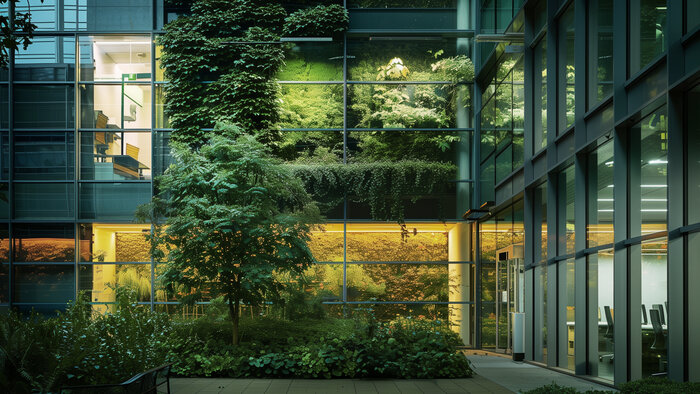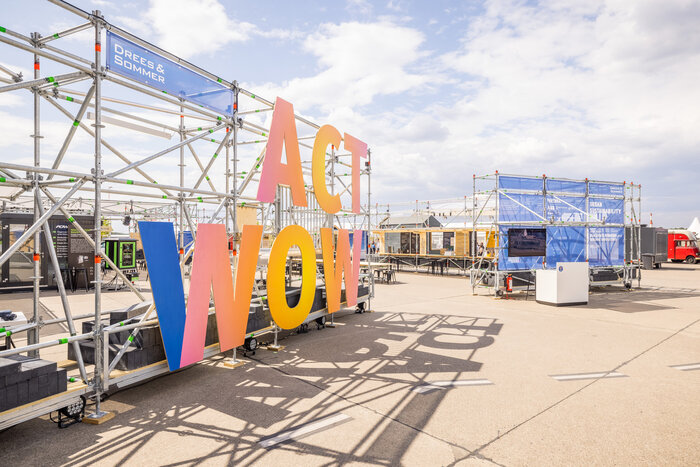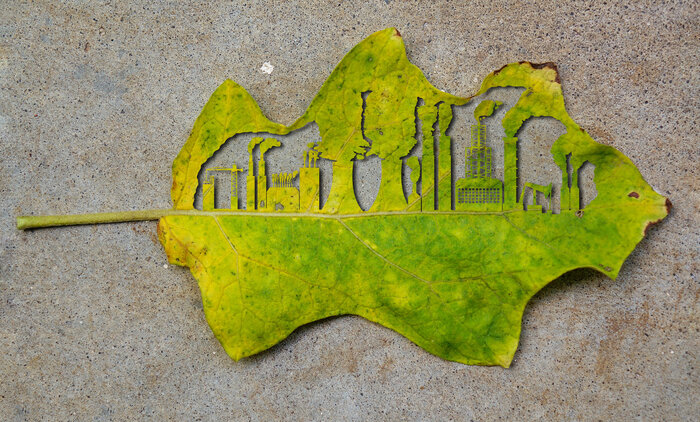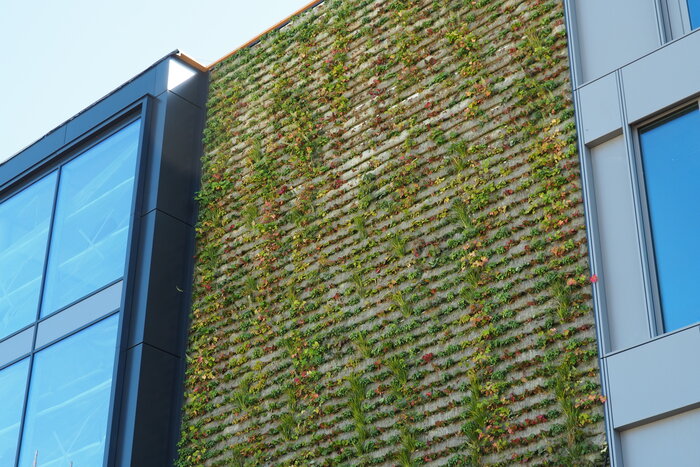Urban heat island

Heat waves are unbearable, especially in cities. Gregor Grassl, Associate Partner and Head of Green Urban Development at Drees & Sommer, knows how to deal with heat stress in urban environments.
Overview of urban heat islands:
- Due to climate change, Germany is experiencing an increase in hot days: in 2022, there were around 17 hot days in Germany with over 30 degrees and tropical nights
- Inner cities are particularly affected by this as the temperature difference between cities and the surrounding area is up to 15 degrees
- Reasons for urban heat islands include sealed surfaces as well as lack of shade and greenery
- Climate adaptation measures such as green facades, unsealing of surfaces, more areas with shade, and many other measures to cool cities are required
Steaming asphalt, glaring light over the roofs, and parched green spaces—Heat waves not only change the cityscape, but also lead to increased stress for city dwellers. This is known as “heat stress” and describes the difference between the perceived temperature and the optimum temperature for the human body. The urban phenomenon of heat islands exacerbates the effects of heat as cities are much warmer than their rural surroundings because they absorb and store more heat. There are many reasons for this, such as high building density, low proportion of green areas, high energy consumption, and low air circulation.
The heat also has negative effects on health, such as heatstroke, dehydration, and cardiovascular and respiratory diseases. Quality of life is also negatively affected as comfort, productivity, and sleep quality decline. The environment also suffers as energy consumption increases for air conditioning, air quality deteriorates, and greenhouse gas emissions increase.
Different measures are required to prevent heat islands and reduce the effects of heat waves in urban areas. Gregor Grassl, Associate Partner at Drees & Sommer with a focus on sustainable urban and neighborhood development (especially climate protection and climate adaptation concepts) knows which measures are required.

Prolonged heat stress can cause circulatory problems, allergic reactions, and respiratory diseases.
Five measures to counteract urban heat
1. Providing sufficient shade
There are direct measures to improve the well-being of urban residents, such as protecting open spaces and paths with trees or other shade elements. Simple methods such as bus stop canopies or benches in the shade allow people to rest when it is very hot. The tree population in cities is important and should be increased. Trees provide shade and cool the air through evaporation. In the long term, the construction of buildings is also relevant because if they are built dense and shady, tall buildings heat up less and thus require less energy for cooling.
“As a rule, shade is simply the best, simplest, and most cost-effective means with the most immediate effect,” Grassl emphasizes.
2. Cooling through green facades and unseal areas
“Trees and other plantings provide shade, cooling, and moisture. The can also help with extreme weather events by serving as a sponge and retention basin during heavy rainfall,” explains Gregor Grassl. Urban greening includes not only trees but also green strips, temporary rain ponds, and green roofs. Vertical green facades, such as those found on the Drees & Sommer office building “OWP12” in Stuttgart, can also be useful.
Unsealing also plays an important role in this. “Squares and paths do not necessarily need to be made of asphalt. Gravel surfaces like in beer gardens or grass pavers for car parks are cheaper and reduce the heat effect,” says Grassl. “Unfortunately, many areas such as traffic islands are still being sealed instead of planting flower meadows there, which could help to promote biodiversity.”
3. Using bright surfaces with high albedo
Urban planners are increasingly using light-colored, reflective materials with low heat storage capacity. These can reduce excessive heat radiation on hot days. Short-wave radiation is reflected, and the material does not heat up. This measure shows particularly positive results in densely built-up areas with large roof surfaces. In concrete terms, this can mean reducing asphalt and metal surfaces, for example. Light-colored concrete surfaces, paved surfaces (made of concrete or natural stone), or gravel-bound surfaces are best suited. A combination of rough surfaces, porous materials, and lighter colors in the covering also provides a lower surface temperature and a higher thermal storage capacity. If necessary, surfaces can be lightened by applying a light color afterwards.
4. Cooling at night with low-energy solutions
Low-tech systems are increasingly being used in buildings. For these systems, a lot of storage mass is built into the building in order to cool it at night using the outside air. During the day, windows and doors remain closed. “When it gets too warm outside at night, this principle no longer works. So in future development, buildings that are actually energy-saving and sustainable will also have to be renovated because of climate change,” Grassl notes.
As alternatives for natural cooling, underfloor heating can also be used relatively easily as cooling floors in summer. One possibility is to cool the water circuit at night and dissipate the heat from the indoor spaces to the outside. It is also possible to use ceilings as cooling surfaces. There are now many projects that use geothermal energy not only for heating, but also for cooling. In combination with solar shading, it is possible to cool for a relatively long time at low cost without increasing energy expenditure.
Low-energy grids can be used for both heating and cooling, creating a neighborhood cycle. Ideally, water is used for cooling in summer and heated as a result of this. The heated water is then stored. In winter, the warm water is used for heating and cooled down again. The advantage of this is that the heat can be returned to the ground in summer through cooling. This process can even have a positive effect on the overall energy balance in summer.
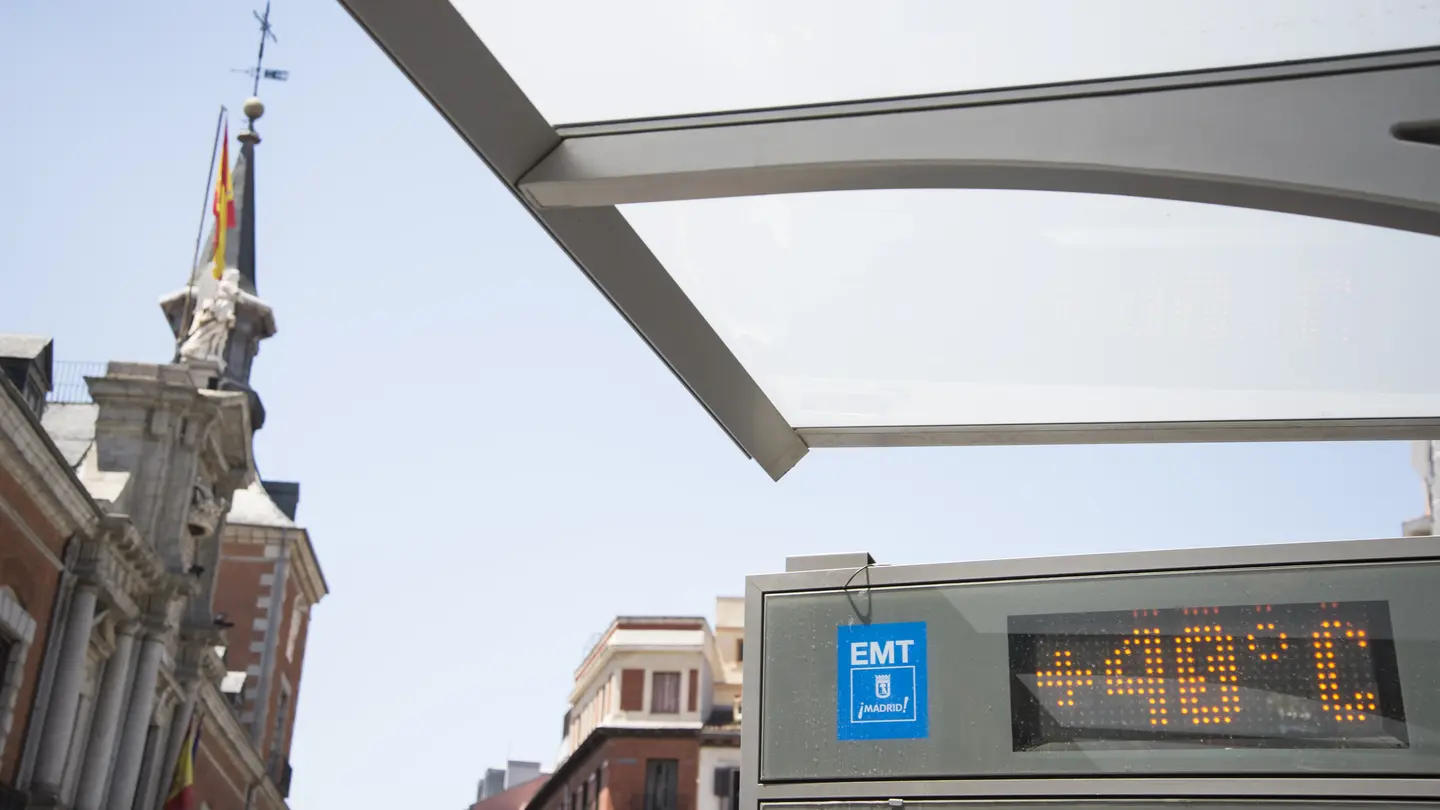
In 2022, there were around 17 hot days in Germany where the temperature exceeded 30 degrees and the nights felt tropical.
5. Building higher against overheating
If buildings seal less area due to their height, both the climate and flood protection benefit. This is because more areas are created for the retention of rainwater.
Gregor Grassl believes there are two further advantages from the perspective of urban ecology: “High-rise buildings provide shade to one other. Shade is the best protection against the heat. Everyone knows this from using sun protection or roller shutters at home. A low window ratio is also important.” The proportion of window area of properties in a sustainable city should not exceed 40 percent. Glass palaces are costly in energy consumption, both in summer and winter, as glass offers poor insulation.
“Another advantage is turbulence and updrafts, which play a role especially in high-rise buildings. This contributes to better ventilation,” he adds. If turbulence occurs, this could lead to draughts and uncomfortable situations. Targeted application, however, promotes cooling and is comparable to natural features such as rivers. This cools through the water and at the same time functions as an open air corridor and ventilation zone.
Two sides of the same coin: climate protection and climate adaptation
Gregor Grassl believes climate protection and climate adaptation are two inseparable dimensions of the climate crisis and should not be played off against each other. “We often talk about whether we should make our roofs greener or better equip them with photovoltaic systems. The former is climate adaptation, the second is climate protection.” Numerous studies show that both can be combined without any problems and that synergies can even result. Photovoltaic modules on green roofs even achieve a higher yield because they work more efficiently due to the cooling of the green roof.
The burden of heat in urban areas is a major challenge for the present and the future. But it also offers an opportunity to make our cities more livable, sustainable, and resilient. Targeted action means we can not only reduce heat stress in cities, but also achieve other benefits such as improved air quality, higher energy efficiency, and greater biodiversity.
